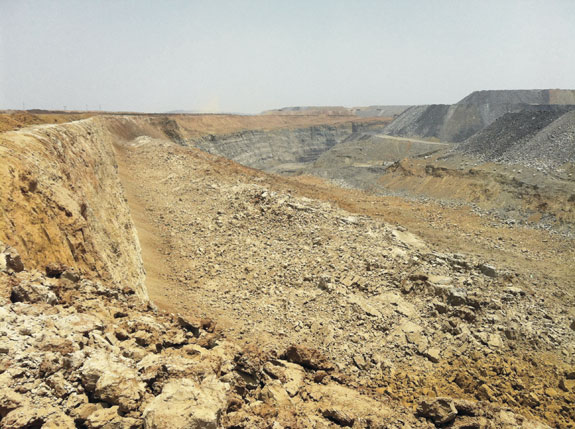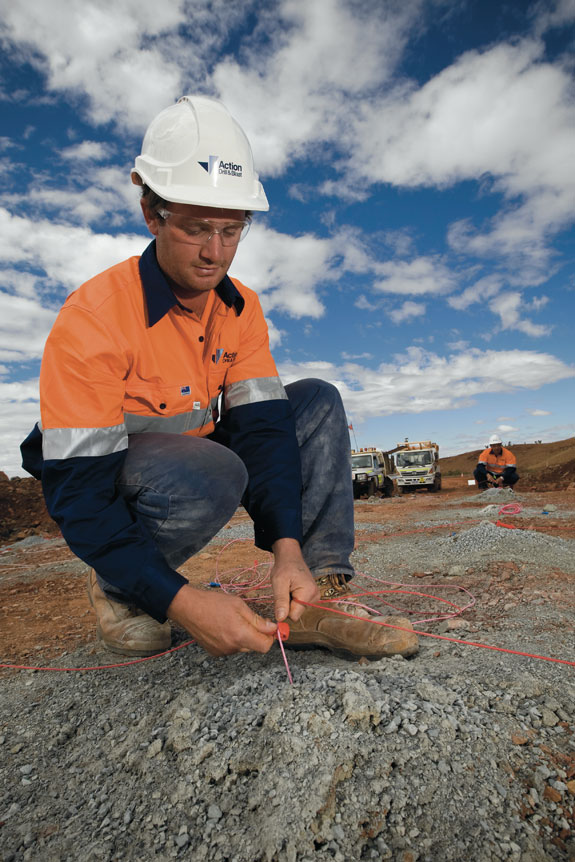Leading the way
Michael Wiseman, Action Drill & Blast
The ongoing reduction in both thermal and metallurgical coal prices is pushing the industry to work more smartly and more efficiently in order to stay competitive. Doing things the same old way simply will not work in today’s market: asset owners and service providers must innovate if they are to survive.
One key opportunity is to use efficient drill-and-blast techniques to increase productivity in subsequent mining processes. If the same machines, personnel and other associated resources on an operation can move and process more material quicker, saleable volumes can rise.
Drilling and blasting more rock to dig faster ultimately costs more. It may be a relatively minor extra cost to the overall operation, but justifying any additional expense in the drill-and-blast process can be difficult. It’s not difficult to see why: any increase in cost is certain but the savings outcome for the miner is speculative. It can be a hard bet to make.
Likewise for the contractor, better explosives, better initiation systems, better skills or technology can all deliver big benefits that outweigh their costs, but these are almost always large changes, requiring new suppliers, supply chains and extensive training. Continuous improvement in these areas must be part of the bigger picture but it strikes a similar impediment to increasing the budget.
If increasing the drill-and-blast budget is not an option, the only avenue left to get the mine producing more by smoother and faster digging is to do more with the same drill-and-blast budget. Instead of buying more drill holes and explosives, the existing plan and budgeted resources must be optimised. The focus needs to be on quality of output instead of quantity of input.
Starting with the small stuff can lead to big benefits through a ‘virtual snowball’. Making small ‘benefit for no cost’ changes can free up time and resources to make the small ‘benefit for tiny cost’ changes. Continually improving and re-investing the benefits facilitates the medium, then big, then reputation-making improvements. The final benefits can be so profound – delivering such large and locked-in improvements to cost and speed of mining – that owners can re-open mothballed mines in a falling market.

Figure 1. Better blasts can be achieved without increasing the drill-and-blast budget.
Motivation and incentive
The first step in this process is to improve team communication and motivation. Minor efficiency gains from within the existing workforce can escalate from minutes or dollars per hour, to hours per day, to saving whole shifts of labour time – and millions of dollars in extra revenue or reduced costs. These gains are free; they require no extra employees or equipment.
The biggest obstacle to this is convincing the very people who know how to improve things that it is in their interests to do so.
Demonstrating to the team how investing time gained into taking better care of machinery and implementing other initiatives to achieve greater competitiveness in the market means more jobs rather than less jobs is important. Once a level understanding and incentive has been achieved, workers are more likely to look for continuous improvement opportunities.
Time usage
Employee motivation and incentive can be channelled into using spare time productively while on shift. Time can be spent learning more about other roles. A driller can assist the fitter on a service to increase the driller’s ability to fix issues before they happen or to help get a drill back up and running more quickly after breakdown. Helping the blast crew will allow them the opportunity to implement practices to improve efficiencies that can save on explosives product, for example.
Alternatively, spare time can be spread out throughout the shift. Drillers can take small blocks of time to sit with colleagues and improve each other’s skills and speed of drilling, complete spot checks or perform maintenance on the rig to reduce breakdown time and further increase drill hours.
If operators are skilled in all facets of drilling and maintenance, the penetration rate on a project has been shown to increase by between 5% and 10%, and rig availability regularly maintained at a minimum of 90%.
Multi-skilled personnel mean that the same work, or even more work, can be done with fewer people and less cost.
Drilling tactics
Targeting efficiencies in blasthole drilling can provide the first productivity gains, as it is an area that is often overlooked in continuous improvement activities.
Blasthole drilling is a relatively repetitive activity, which the driller carries out in isolation. As a result, the driller does not engage in regular communication with related personnel, such as engineers, fitters and shotfirers. The minimal level of interaction with colleagues provides limited opportunities to share skills and provide feedback on improvement ideas.
An additional opportunity surrounds how performance is typically measured. Most commonly, blasthole drilling is measured in terms of immediate performance rather than hole quality: penetration rates for a shift, hours drilled or metres drilled are priorities over ensuring the holes last. A driller is usually instructed to drill to a certain depth, with an engineer estimating an appropriate fallback buffer as a significant proportion of the holes fall back over time. This is brought to the attention of the blast crew normally long after the drill has left and part of the pattern either has to be re-drilled to get the optimum blast result or a poorer blast result is accepted.
This can be compared with a situation where a driller is tasked with achieving a certain depth when the blast crew arrive. Drillers begin to measure the holes before and after the job and drilling practices will be amended to reduce fallback – or if it is a natural feature of the ground in that area, then extra metres will be drilled to accommodate. Holes drilled a few days before are measured to see how things have changed over time; holes at the start of a pattern are given a little extra depth than those last to be drilled. Not only does this result in a better blast but minimises the need to move drills to re-drill holes, saving time and reducing costs.
On a project in Queensland’s coal-rich Bowen Basin, a drill maintained and operated by a contracted drill-and-blast team regularly achieved 20% to 25% more production than drills of the exact same model maintained and operated by the client, with fewer re-drills. With identical equipment, the difference came down to the contractor’s people and processes.

Figure 2. A shotfirer ties in a blasthole.
Optimising drill rigs
Exceeding targets with the same or lower costs allows for funds to accumulate for the big initiatives that require not just ideas and time, but money too – technology, training and R&D, including the upgrading and modification of equipment.
Possessing the resources and capability to enhance drill rigs to compete against more expensive and larger machines opens up significant opportunity for cost and productivity benefits.
In the competitive environment that is mining, it is common for drill manufacturers to compete in ‘classes’ based on their drill diameter capability.
Big drills are more expensive to purchase, operate and maintain – but they drill larger diameter holes, which is where they deliver their cost benefits. The geometry of blasting is generally a squared relationship – if the diameter of the drill bit is doubled, the number of holes needed will be reduced by a factor of four. Fewer holes means drill patterns can be drilled more quickly and less explosives accessories are required. The cost of achieving the end result – blasted material – is cheaper than if the same amount of work had been done with smaller drills.
However, this presents challenges if a mine has varying blast requirements and/or if reducing dilution and ore loss are key objectives.
It means the blast will be designed around the capabilities of the drill available rather than designed to maximise the explosive energy. It can result in a sub-optimum blast to the detriment of subsequent mining activities and project costs. Alternatively, it means acquiring an additional drill at more cost.
Solutions-focused drill-and-blast teams are finding ways to overcome this issue by optimising smaller rigs to drill larger hole sizes, effectively enabling them to perform in a higher drill class but without the additional operating costs associated with running a larger item of equipment.
These optimised rigs use multiple bit diameters and can perform angled drilling to suit varying ground types, final wall designs and bench heights. The capability to drill a wide variety of blasthole sizes means the drill-and-blast team can get the most efficient work out of the explosives and therefore deliver the best downstream benefits to the mine, such as better rock fragmentation, to improve dig rates and crusher throughput, optimal muckpile profiles and better final wall stability.
This approach has been delivering value in the Bowen Basin where an experienced drill-and-blast team engineered modifications to a standard Atlas Copco Pit Viper 275 (PV275). The engineering improved the rig’s flexibility, enabling it to compete against its larger and more expensive cousins.
The optimised PV275 drills three different size holes: 229 mm, 251 mm and 270 mm. Its standard set up is just 251 mm and 270 mm. There is no requirement for additional equipment to drill thinner holes and custom-made rods also facilitate increased depth, which enables the rig to drill 20% deeper than the standard PV275 model and with equal efficiency.

Figure 3. Multiskilling is critical to cost efficiencies.
Focusing on the core goal
Remember, the only purpose of drilling blastholes is to facilitate the efficient distribution of explosive energy within the rock mass, where the same chemical energy will deliver more useful work than if it was piled up on the surface. The optimum depths and diameters of the blastholes to be drilled in any drill-and-blast project depend on the type and depth of the rock being broken, the type of explosives being used to break it and the objectives of the blast. As ground conditions can vary significantly in a single project, the ability to tailor the drilling accordingly is the ideal approach to achieve an optimal blast.
With an innovative approach and a commitment to continuous improvement, the outcome can be improved dramatically. Better drilling and better blasting means faster digging.
This article first appeared in World Coal August. To read this and much more, register to receive a copy here.
Read the article online at: https://www.worldcoal.com/special-reports/02082016/leading-the-way-2136/
You might also like
Coal exit and workforce shortages keep short-term Australian power prices high
Cornwall Insight has reported that the ongoing phase-out of coal facilities and the sluggish progress in launching new renewable energy projects is poised to push Australian electricity prices higher until 2030.

